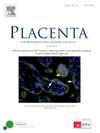Physiological glucose levels associated with gestational diabetes impact the human placental transcriptome in an ex vivo model
IF 3
2区 医学
Q2 DEVELOPMENTAL BIOLOGY
引用次数: 0
Abstract
Introduction
Gestational diabetes mellitus (GDM) increases the risk of pathological fetal growth, including rates of large-for-gestational age (LGA) infants, which in turn increases the risk of offspring later developing cardiometabolic complications. Recent continuous glucose monitoring (CGM) studies have revealed that temporal periods of mild hyperglycaemia are linked to LGA, and too tight glycaemic control can increase periods of maternal hypoglycaemia and increase the risk of delivering small-for-gestational age (SGA) infants. The underlying mechanisms are unclear but likely involve the placenta.
Methods
Ex vivo human placental explants from term uncomplicated pregnancies were cultured in varying glucose concentrations for 48 h to recapitulate in vivo maternal glucose profiles. Glucose, osmolality, human chorionic gonadotrophin (hCG) and lactate dehydrogenase (LDH) were measured in conditioned medium, and RNA sequencing performed, followed by functional enrichment analysis (FEA).
Results
Medium changes every 6–18 h in variable (5/5.5 mM), or constant 5 mM or 7 mM glucose were appropriate to model maternal normoglycaemia, periods of mild hypoglycaemia and periods of mild hyperglycaemia, respectively. There were 61 differentially expressed genes (DEGs) in explants cultured in mild hyperglycaemic conditions and 54 DEGs in mild hypoglycaemic conditions. FEA revealed that transcripts altered by mild hyperglycaemia were associated with vascular development and lipid metabolism/homeostasis, whilst those altered by mild hypoglycaemia were associated with cell turnover.
Conclusions
Together this data demonstrates that subtle changes in maternal glucose impact the placenta and may contribute to altered fetal growth. This highlights the importance of employing CGM in pregnancies complicated by GDM and utilising physiological glucose levels in ex vivo/in vitro placental studies.
在离体模型中,与妊娠糖尿病相关的生理葡萄糖水平影响人类胎盘转录组
妊娠期糖尿病(GDM)增加病理性胎儿生长的风险,包括大胎龄(LGA)婴儿的发生率,这反过来又增加了后代后来发生心脏代谢并发症的风险。最近的连续血糖监测(CGM)研究表明,轻度高血糖的时间周期与LGA有关,过于严格的血糖控制会增加产妇低血糖的时间,增加分娩小胎龄(SGA)婴儿的风险。潜在的机制尚不清楚,但可能与胎盘有关。方法采用不同葡萄糖浓度培养足月无并发症人胎盘外植体48 h,以重现母体体内葡萄糖特征。在条件培养基中测定葡萄糖、渗透压、人绒毛膜促性腺激素(hCG)和乳酸脱氢酶(LDH),进行RNA测序,然后进行功能富集分析(FEA)。结果每6-18 h改变一次培养基(5/5.5 mM),或固定5 mM或7 mM葡萄糖,分别适合于模拟产妇的正常血糖、轻度低血糖和轻度高血糖。在轻度高血糖条件下培养的外植体中有61个差异表达基因,在轻度低血糖条件下培养的外植体中有54个差异表达基因。FEA显示,轻度高血糖改变的转录本与血管发育和脂质代谢/体内平衡有关,而轻度低血糖改变的转录本与细胞更新有关。综上所述,这些数据表明母体葡萄糖的细微变化会影响胎盘,并可能导致胎儿生长的改变。这突出了在妊娠合并GDM中应用CGM和在离体/体外胎盘研究中利用生理葡萄糖水平的重要性。
本文章由计算机程序翻译,如有差异,请以英文原文为准。
求助全文
约1分钟内获得全文
求助全文
来源期刊

Placenta
医学-发育生物学
CiteScore
6.30
自引率
10.50%
发文量
391
审稿时长
78 days
期刊介绍:
Placenta publishes high-quality original articles and invited topical reviews on all aspects of human and animal placentation, and the interactions between the mother, the placenta and fetal development. Topics covered include evolution, development, genetics and epigenetics, stem cells, metabolism, transport, immunology, pathology, pharmacology, cell and molecular biology, and developmental programming. The Editors welcome studies on implantation and the endometrium, comparative placentation, the uterine and umbilical circulations, the relationship between fetal and placental development, clinical aspects of altered placental development or function, the placental membranes, the influence of paternal factors on placental development or function, and the assessment of biomarkers of placental disorders.
 求助内容:
求助内容: 应助结果提醒方式:
应助结果提醒方式:


